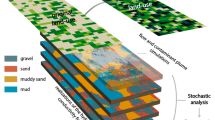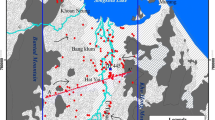Abstract
This study demonstrates the application of a stochastic procedure to enhance confidence in the predictions of numerical groundwater flow models. The objective was to assess the hydrogeological conditions and groundwater potential of a semi-confined aquifer system in Legon, Accra. The study applied the parameter randomization procedure in the Groundwater Modelling System (GMS) to evaluate model uncertainties arising from uncertainties in the data of model input parameters. A total of 2500 equally likely solutions of the numerical model were simulated through the Latin hypercube stochastic option. Regarding the size of the terrain and the number of parameters used for calibrating the model, the 2500 model realizations were adjudged to be largely sufficient to represent the possible solutions that could arise from the various permutations of the parameter data. High variances would suggest significant differences in the realizations, indicating high levels of non-uniqueness in the solutions. The 2500 solutions were compared using standard deviations computed from the differences in the estimated horizontal hydraulic conductivity, specific yield and specific storage estimates. The transient model calibrated for this domain suggests very close similarities in the model-computed aquifer parameters for all the 2500 solutions. This suggests that any of the solutions could be used to represent the conditions prevailing in the domain. Risk analyses were then performed on abstractions through all the 2500 solutions. The study shows that the domain is sustained largely by lateral subsurface inflows from adjoining areas amounting to 399,278 m3/day, with direct vertical infiltration and percolation of precipitation accounting for an average of 2450 m3/day. The analysis suggests that at this rate of input, the domain can sustain groundwater abstraction to meet all water needs in the area. In addition, the domain has demonstrated resilience against annual increment in abstraction rates by 5 % over a 20-year period at the current recharge conditions. However, increasing abstraction rates by up to 200 % of the current abstraction rates over the 20-year period (2015–2035) but with a gradual decrease in groundwater recharge by up to 10 % over the period will result in drastic lowering of the hydraulic head especially in the south-central portions of the domain. This situation might induce reversal of the current flow and potentially lead to contamination and/or aquifer dewatering in the domain.








Similar content being viewed by others
References
Acar O, Klammler H, Hatfield K, Newman MA, Annable MD, Cho J, Parker BL, Cherry JA, Pehme P, Quinn P, Kroeker R (2013) A stochastic model for estimating groundwater and contaminant discharges from fractured rock passive flux meter measurements. Water Resour Res:49. doi:10.1002/wrcr.20109
Anderson MP, Woessner WW (2002) Applied groundwater modeling, simulation of flow and advective transport. Academic Press, New York, NY
Aquaveo (2008) Groundwater Modelling System, Version 7.2. Tutorial, stratigraphy modeling, horizons and solids.
Aquaveo (2014) Aquaveo Groundwater Modeling System (GMS) version 9.1.1.0.
Attandoh N, Yidana SM, Aliou AS, Sakyi PA, Banoeng-Yakubo B, Nude PM (2013) Conceptualization of the hydrogeological system of some sedimentary aquifers in Savelugu-Nanton and surrounding areas, northern Ghana. Hydrol Process 27:1664–1676. doi:10.1002/hyp.9308
Baaloussha H, Kӧngeter J (2006) Stochastic modelling and risk analysis of groundwater pollution using FORM coupled with automatic differentiation. Adv Water Resour 29:1815–1832
Banoeng-Yakubo B, Danso S, Tumbulto J (2005) Assessment of pollution status and vulnerability of water supply aquifers in Keta, Ghana. Final Report. 120.
Boronina A, Renard P, Balderer W, Christodoulides A (2003) Groundwater resources in the Kouris catchment (Cyprus): data analysis and numerical modelling. J Hydrol 271:130–149
Chang CM, Yeh HD (2012) Investigation of solute transport in nonstationary unsaturated flow fields. J Hydrol Earth Syst Sci 16:4049–4055
Darko PK (2001) Quantitative aspects of hard rock aquifers: regional evaluation of groundwater resources in Ghana, Ph.D. Thesis, Inst. Hydrogeo., Eng. Geol. and Appl. Geophy., Charles Univ., Prague Czech.
Ernstson K, Kirsch R (2006) The transient electromagnetic methods. In: Krisch R (ed) Groundwater geophysics: a tool for hydrogeology. Springer, Berlin, pp. 179–226
Ga East Municipal Assembly (2006) Retrieved June 23, 2015, from http://gaeast.ghanadistricts.gov.gh.
Grant NK (1969) The late Precambrian to early Paleozoic pan-African orogeny in Ghana, Togo, Dahomey, and Nigeria. Geol Soc Am Bull 80:45–55
Harbaugh AW (2005) MODFLOW-2005, The U.S. Geological Survey modular ground-water model—the ground-water flow process. U.S. Geological Survey Techniques and Methods. 6-A16.
Harte TP, Konikow LF, Hornberger GZ (2006) Simulation of solute transport across low permeability barrier walls. J Contam Hydrol 85:247–270
Hill MC, Banta ER, Harbaugh AW, Anderman ER (2000) MODFLOW-2000, the U.S. Geological Survey modular ground-water model—user guide to the observation, sensitivity, and parameter-estimation processes and three post-processing programs, Open-File Report 00–184, U.S. Geological Survey.
Hu L, Chen C, Chen X (2011) Simulation of groundwater flow within observation boreholes for confined aquifers. J Hydrol 398:101–108
Humphrey S 2008 A stochastic approach to a groundwater flow model of southern Honey Lake Valley in Lassen County, CA and Washoe County, NV. MSc Thesis, University of Nevada, Reno, USA.
Junner NR, Hirst T (1946) The geology and hydrology of the Voltaian Basin. Gold Coast Geological Survey. Memoir 8:50
Jusseret S, Tam VT, Dassargues A (2009) Groundwater flow modeling in the central zone of Hanoi, Vietnam. Hydrogeol J 17(4):915–934
Kesse GO (1985) The Mineral and Rock Resources of Ghana. Balkema, Rotterdam, pp. 9, 44.
Kortatsi BK (2006) Hydrochemical characterization of groundwater in the Accra Plains of Ghana. Environ Geol 50(3):299–311
Lambert PM (1995) Numerical simulation of ground-water flow in basin-fill material in Salt Lake Valley, Utah. Utah Department of Natural Resources. Technical Publication 110-B, Salt Lake City, Utah.
McLaren RG, Forsyth PA, Sudicky EA, van der Kwaak JE, Schwartz FW, Kessler JH (2000) Flow and transport in fractured tuff at Yucca Mountain: numerical experiments on fast preferential flow mechanisms. J Contam Hydrol 43:211–238
Morrison HF, Gasperikova E (2012) DC resistivity and IP field systems, data processing and interpretation.
Poeter E, Anderson DR (2005) Multimodel ranking and inference in groundwater modelling. Ground Water 43:597–605
Shikaze SG, Sudicky EA, Schwartz FW (1998) Density-dependent solute transport in discretely-fractured geologic media. J Contam Hydrol 34(10):273–291
van der Hoven SJ, Solomon DK, Moline GR (2002) Numerical simulation of unsaturated flow along preferential pathways: implications for the use of mass balance calculations for isotope storm hydrograph separation. J Hydrol 268:214–233
Vereecken H, Doring U, Hardelauf H, Jaekel U, Hashagen U, Neuendorf O, Schwarze HR, Seidemann H (2000) Analysis of solute transport in a heterogeneous aquifer: the Krauthausen field experiment. J Contaminant Hydro 45:329–358
Yidana SM (2011) Groundwater flow modelling and particle tracking for chemical transport in the southern Voltaian aquifers. Environ Earth Sci 63:709–721
Yidana SM, Chegbeleh LP (2013) The hydraulic conductivity field and groundwater flow in the unconfined aquifer system of the Keta Strip, Ghana. J Afr Earth Sci 86:45–56
Yidana SM, Fynn OF, Chegbeleh LP, Loh Y, Addai MO (2014) Analysis of recharge and groundwater flow in parts of a weathered aquifer system in northern Ghana. J Appl Water Eng Res 2(2):91–104
Zhang Q, Volker RE, Lockington DA (2004) Numerical investigation of seawater intrusion at Gooburrum, Bundaberg, Queensland, Australia. Hydrogeol J 12:674–687
Author information
Authors and Affiliations
Corresponding author
Rights and permissions
About this article
Cite this article
Bosompemaa, P., Yidana, S.M. & Chegbeleh, L.P. Analysis of transient groundwater flow through a stochastic modelling approach. Arab J Geosci 9, 694 (2016). https://doi.org/10.1007/s12517-016-2733-y
Received:
Accepted:
Published:
DOI: https://doi.org/10.1007/s12517-016-2733-y




